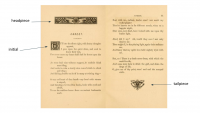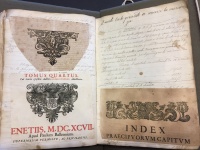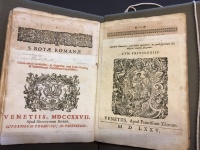Printer's Ornaments
Introduction
Have you ever flipped through a book and noticed stylized and colored letters or borders? Have you ever wondered why they were emphasized? These letters are derivatives of printer’s ornaments, decorations used for both form and function in printing. But what exactly are printer’s ornaments, and why should we care? Through the analysis of two objects pertaining to printer’s ornaments—as well as a miniature case study on a particular printer’s ornament—we will see how the significance of printer’s ornaments has developed and changed between different cultures and time periods.
Printer's Ornaments 101
Printer’s ornaments (other names include wingdings and printer’s flowers) is a fairly all-encompassing term describing printed decorative and stylistic elements used in books [1]. A more technologically-specific definition refers to printer’s ornaments themselves as wooden or metal letterpress blocks engraved with relief designs for printing alongside the text of a book [1].
Printer's ornaments originated from early hand-drawn letters embellishments in monastic scripts and manuscripts [2]. Similar to early illumination techniques, printer's ornaments added color and beauty to an otherwise black text-filled page [3]. The earliest printer's ornaments were exclusively made of wood; post-sixteenth century, artisans transitioned into making printer's ornaments out of metal casting. Most printer's ornaments were carved in intaglio, where workers used burins--sharp, steel rods--to carve out grooves, shapes, and textures in wood blocks or metal plates [4]. When used, finished ornaments were first covered with ink and pressed onto paper to reproduce the engraved image. Printer's ornaments that were carved using woodcuts could be arranged alongside text and printed simultaneously.

There are many different types of printer’s ornaments, the most common being headpieces, tailpieces, and initials that are found on page tops, page bottoms, and section headings, respectively (see Fig. 1). Printer’s ornaments served a wide variety of purposes for both form and function. They added beauty and color to otherwise black text, and some even provided information towards understanding the text. On a more practical note, printer’s ornaments provided support in empty spaces within a printing frame, thereby preventing warping or distortion of paper and ensuring a certain quality of print [1]. Moreover, some printer’s ornaments were accompanied by information about the printer, location, and year in which the text was printed [5].
As printing entered the digital age, printer’s ornaments lost their practical, page-holding purposes and are now relatively obsolete. However, historical remnants of printer’s ornaments exist within volumes such as Album de stampine antiche and Henry Plomer’s English Printers’ Ornaments. These two volumes represent two very different perspectives on “collecting” and “reading” printer’s ornaments, especially since they demonstrate a trend in printer’s ornaments from aesthetic visuals to scholarly resources in different time periods. Moreover, the portability—both physical and meaningful—of printer’s ornaments can be explored through a brief study of a reoccurring printer’s ornament depicting a bear-hunting scene, with this particular ornament present in both Album and English Printers’ Ornaments and how this particular ornament was presented in these volumes.
Album de stampine antiche

The Album de stampine antiche (or “Antique stamps album”) is a phenomenal example of a compilation of printer’s ornaments. Created during the nineteenth century in Florence, Italy, Album is a scrapbook that contains hundreds of cutouts from books, featuring over 350 different kinds of printer’s ornaments. The creator of Album has remained unknown; however, it is believed that someone in the Peruzzi family was involved, seeing as there are many instances of a “Caroli Peruzzi” leaving his signature within the book. The printer’s ornaments featured are all from books published between the mid-sixteenth to late-eighteenth centuries, thereby demonstrating the longevity of printer’s ornaments during the time [6]. These printer’s ornaments are especially unique because they are all cutouts, specimens of original pieces from books (as opposed to reproductions or scans). Additionally, Album is not a book solely dedicated to printer’s ornaments; the scrapbook element comes from the fact that these cutouts were pasted on top of a book that was previously used for business transactions of a sort, a nod towards the possibility of the Peruzzi family being involved in the creation of Album as they were a prominent banking family at the time (see Fig. 2). The juxtaposition of calligraphic text against bold images is quite vivid and highlights the scrapbook elements of Album quite well.

Another notable physical feature of Album includes its composition of printer’s ornaments which highlights the creator's choices. Many of the printer’s ornaments were cut from title pages, and whoever cut them out also included surrounding printed information on the title, publisher, and location and date of production as well. While most locations were domestic—Venice, Rome, Florence, for instance—others were international—take Geneva, Lyon—thus demonstrating how book production and circulation was widespread throughout Europe at the time. From a purely syntax perspective, printer's ornaments only refer to the images themselves (and not the the words), so the fact that the creator decided to cut out these additional snippets speaks to the idea of aesthetics in identification, as if the printer's ornaments themselves "lose" meaning without the titles, locations, or dates.
Similarly, Album is not arranged in any particular order; similar printer's ornaments (or identical ones, as indicated below) are not grouped together, and the printer's ornaments themselves are pasted in a rather haphazard manner across the volume. This obviously points more towards the creator of Album and their perspective on printer's ornaments; by opting to paste the printer's ornaments randomly throughout the book, the creator demonstrates some sort of urgency in their actions. In this case, they pay more attention towards the act of preserving the printer's ornaments as opposed to organizing them in some pattern.
In many ways, Album goes directly against the idea of printer’s ornaments as enhancing text because the book is almost solely made up of these cutouts, with the existing text having little to no relation to the images themselves. Similarly, the fact that these cutouts were pasted over a used book and not a blank book indicates some sort of connection or discrepancy in the value of text versus images, as if the creator thought that the cutouts themselves may not have been worth pasting into a new book but were somehow still more significant than the words written on the pages. Although there is a possibility that the cost of paper (or producing books) played a role in the creator’s decision to create Album out of a used book, this does not excuse the fact that this shows how people placed different sorts of significance and importance upon books, leading to the expendability of books (and their contents) at that time. In today’s society, most books are maintained in their original form, yet the fact that someone could so brazenly cut up a book just to remove its decorative elements—printer’s ornaments, in this case—is a concept that may seem foreign to most of us.
With regards to the balance and the relationship between reading and writing, Album demonstrates how these two concepts were heavily skewed, especially with the fact that the printer's ornaments were the only artifacts preserved by the creator from the books of the time. The production cost of writing (including publishing and production) is relatively higher compared to that of reading (simply opening a book), but this cost is not reciprocated by the creator of Album as evidenced by their rather careless handling of their books (from which they removed printer's ornaments). Interestingly enough, the cutout nature of Album also speaks towards a culture that is heavily dependent and concerned with appearances and aesthetics, especially from a visual perspective. The lack of text featured in Album points to a society that was very much concerned with the appearance and beauty of books rather than their textual contents. In fact, the very action of cutting out printer's ornaments from books and pasting them over text in another book implies some sort of importance of preserving the art rather than the words.
Album also hints at some possible social and economic implications with how books were disseminated across the population. Given the relatively high cost of books in that time, only the rich or well-connected would have access to books, with wealthy families--such as the Peruzzis--being able to have access to many books--as evidenced by the magnitude of varied cutouts in Album--while others may not have had the same opportunity to do so.
English Printers' Ornaments
A Peculiar Case of Bears
More Stuff!
Notes
- ↑ 1.0 1.1 1.2 Plomer, Henry R. English Printers’ Ornaments. Grafton & Co. Coptic House, 1914. (digitizing sponsored by York University—University of Toronto Libraries)
- ↑ Reilly, Elizabeth Carroll. A dictionary of colonial American printer’s ornaments and illustrations. American Antiquarian Society, 1975.
- ↑ “Printers Ornaments.” BiblioOdyssey, 6 Apr. 2008, bibliodyssey.blogspot.com/2008/04/printers-ornaments.html
- ↑ A Database of Eighteenth-Century Printers’ Ornaments. Fleuron: A Database of Eighteenth-Century Printers’ Ornaments, fleuron.lib.cam.ac.uk/index.
- ↑ Creel, Sarah, “(Re)framing Eliza Haywood: Portraiture, Printer’s Ornaments, and the Fashioning of Female Authorship.” Journal for Early Modern Cultural Studies. Vol. 14., No. 4, University of Pennsylvania Press, 2014.
- ↑ “Album de stampine antiche.” University of Pennsylvania Finding Aids, http://dla.library.upenn.edu/cocoon/dla/ead/ead.html?start=25&id=EAD_upenn_rbml_PUSpMsCodex1859&.
Album de stampine antiche, Ms. Codex 1859, Kislak Center for Special Collections, Rare Books and Manuscripts, University of Pennsylvania.
“Album de stampine antiche.” University of Pennsylvania Finding Aids, http://dla.library.upenn.edu/cocoon/dla/ead/ead.html?start=25&id=EAD_upenn_rbml_PUSpMsCodex1859&